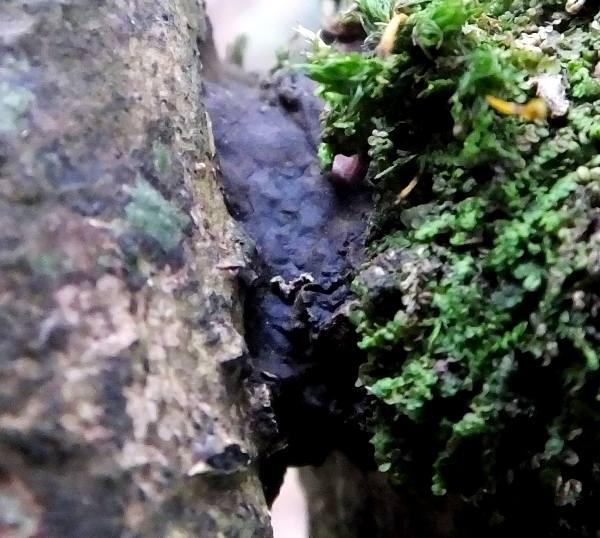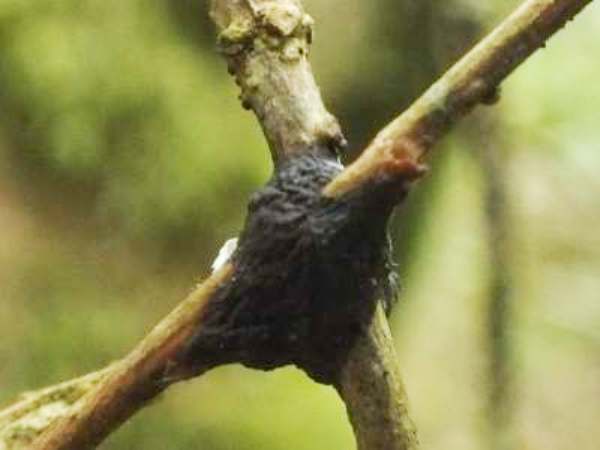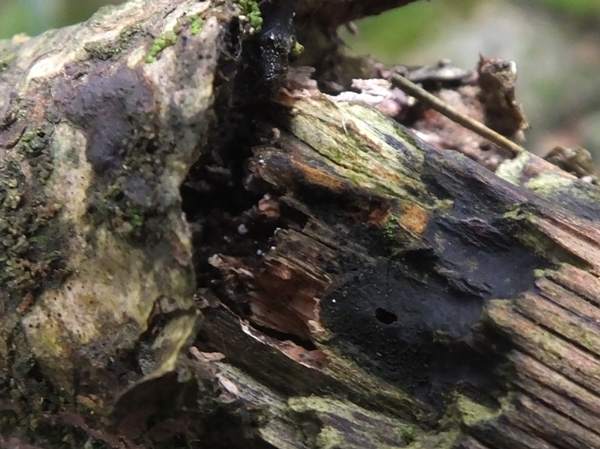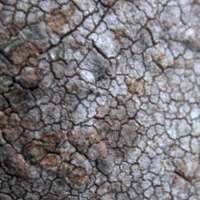Hymenochaete corrugata (Fr.) Lév. - Glue Crust
Phylum: Basidiomycota - Class: Agaricomycetes - Order: Polyporales - Family: Hymenochaetaceae
Distribution - Taxonomic History - Etymology - Identification - Reference Sources

This easily-overlooked crust fungus gets its name from its habit of migrating from one tree to another by gluing together twigs or small branches that are in contact. Although common in Britain, this crust fungus raises excitement when it is parasitised by the rare Hazel Gloves Hypocreopsis rhododendri.

Distribution
Widespread but localised in Britain and Ireland, Glue Crust is also fairly common across much of mainland Europe and parts of North America.

Taxonomic history
When, in 1815, Swedish mycologist Elias Magnus Fries described this crust fungus he named it Thelephora corrugata. The currently-accepted scientific name dates from an 1846 publication by French mycologist Joseph-Henri Léveillé (1796 - 1870).
Synonyms of Hymenochaete corrugata include Thelephora corrugata Fr., Corticium corrugatum (Fr.) Fr., Stereum corrugatum (Fr.) Quél., Hymenochaete agglutinans Ellis, Hymenochaete croceoferruginea Massee, and Hymenochaete corrugata f. conglutinans Bourdot & Galzin. Since its publication in 2012 some authorities have adopted a new genus, in which the Glue Crust fungus becomes Pseudochaete corrugata (Fr.) S. H. He & Y. C. Dai. This species has recently (2019) been reclassified as Hydnoporia corrugata (Fr.) K.H. Larss. & Spirin and this may become its generally accepted name.

Etymology
Hymenochaete, the genus name, comes from hymen- a prefix referring to the fertile membrane (the crust surface), and -chaete from the Greek noun chaite meaning long hair and probably therefore referring to the fine hairs (settae) on the upper surfaces of fungi in this group.
The specific epithet corrugata means wrinkled or corrugated and refers to the often undulating and sometimes warty surface of this crust fungus.
Identification guide
 |
Outer (fertile) surfaceFruitbodies form resupinate crusts 0.1 - 0.2mm thick, firmly attached to the substrate. The pale grey to brownish fertile surface is tinged lilac; it is uneven (corrugated) but seems fairly smooth until you look at it with a hand lens; then very fine surface hairs (settae) are visible. The mycelium spreads along twigs, sometimes contacting another touching twig and 'gluing' the two together. Brown but sometimes with a blackish skin, with age the fruitbodies tend to develop surface cracks rather like miniature crazy paving or dried mud at the bottom of a lake during severe drought. |
SporesEllipsoidal, smooth, 4.5-6 x 1.5-2μm; inamyloid. Spore printWhite. |
|
Odour/taste |
Not distinctive. |
Habitat & Ecological role |
On living and dead broadleaf deciduous trees and shrubs, particularly hazel but also willows and occasionally other hardwoods. |
Season |
Perennial crusts persist throughout the year, but the growing season in Britain and Ireland is sumer and autumn. |
Culinary Notes
Glue Crust Hymenochaete corrugata is thin, tough and leathery, and so it can have no culinary value.
Reference Sources
Mattheck, C., and Weber, K. Manual of Wood Decays in Trees. Arboricultural Association 2003.
Fascinated by Fungi, 2nd Edition, Pat O'Reilly 2016, reprinted by Coch-y-bonddu Books in 2022.
Dictionary of the Fungi; Paul M. Kirk, Paul F. Cannon, David W. Minter and J. A. Stalpers; CABI, 2008
BMS List of English Names for Fungi
Taxonomic history and synonym information on these pages is drawn from many sources but in particular from the British Mycological Society's GB Checklist of Fungi.
Acknowledgements
This page includes pictures kindly contributed by Richard Shotbolt.
Fascinated by Fungi. Back by popular demand, Pat O'Reilly's best-selling 450-page hardback book is available now. The latest second edition was republished with a sparkling new cover design in September 2022 by Coch-y-Bonddu Books. Full details and copies are available from the publisher's online bookshop...

